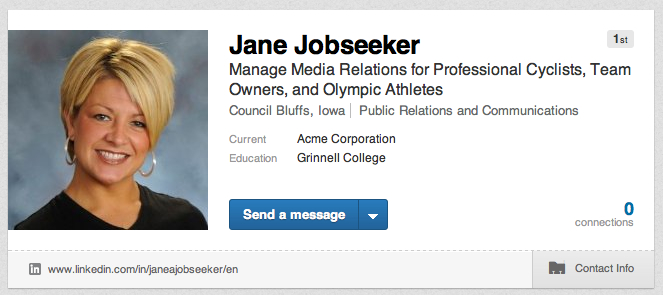
Recruiters and hiring managers either love or hate virtual media-rich resumes.
These online/virtual resumes come in a variety of forms. For example, a media-rich resume could be a presence on VisualCV.com or Purzue.com, or more specifically, a page/website of your own; e.g. yourname.com.
What perks can you expect from a media-rich resume?
Not only are these resumes a “barrel of fun” to produce, one of the biggest perks to having one is flexibility. Sites like VisualCV and Purzue offer you the ability to publish more in-depth career details and embed videos and images, present a portfolio, and offer visitors a downloadable copy of your brag book, resume, and so on.
Let’s examine a few pros and cons to media-rich resumes:
PROS
- Particularly useful for people in non-standard careers such as creative arts, the entertainment industry, or a vast range of marketing positions where video and/or audio work product can demonstrate expertise and competencies.
- Helps executives with long career histories showcase their talents in more depth. Not restricted by length as with standard resumes that follow one to two-page guidelines.
- Ability to embed video, images, audio and portfolio presentations that showcase the media you offer relevant to the job seeker’s desired position or highlight your expertise in focused areas.
CONS
- Cannot be customized for each position or industry. While you may have separate pages in the online resume dedicated to different industries, your strengths may be diluted and not specific enough for some positions.
- Videos may do more harm than good if they are too long (over 2 minutes) and if not created professionally or with high-quality content and form. They may make you look like an amateur and not the executive expert you truly are.
- Can open up the door for identity theft. Don’t be tempted to use your physical address (city and state are sufficient) on the online resume. Be cautious and create a contact email address that is unique and only used for job search.
Should you run out and get a media-rich resume?
Not so fast.
Alternate resume formats, like a media-rich resume, have yet to prove themselves to the hiring community. After all, we estimate that a resume gets so little attention (seconds), so why would we think that another resume format would garner any amount of attention too.
Don’t want to use one of the above recommended media-rich platforms?
No problem.
You have an alternative: your LinkedIn profile.
LinkedIn allows you to upload video, images, documents, and presentations to your LinkedIn page. If you don’t fully understand how to leverage your LinkedIn profile, be sure to check out these LinkedIn profile writing services.
Few professionals using LinkedIn know that…
You can also link to your Twitter page from LinkedIn and also link to your portfolio, personal website, and your blog.
Most all employers and recruiters now check a potential candidate’s LinkedIn profile before considering that person for an open executive position. Since LinkedIn has revolutionized the virtual resume, there really isn’t a need to pursue other online resume options.
There are several components that recruiters and HR managers expect to see in your LinkedIn profile.
For example, the below isn’t a complete list, yet will provide you with some quick starting points. Check out this article to learn more about how to flesh out your LinkedIn profile to include what recruiters want and expect to see.
First, your profile photo on LinkedIn (your online media-rich resume) is very important.
Did you know that profiles with pictures attract 50-70 percent more inquiries than profiles without pictures?
Here are some tips for your LinkedIn photo:
• Don’t use an old photo. There are few things worse than meeting someone for the first time and not recognizing them because the profile on their LinkedIn profile is from 10 years ago (or longer)!
• Use a photo of you in your profile — don’t use a photo of an object.
• Consider using a full body shot of you sitting or standing. At a minimum, your photo should include your head and shoulders, not just a close-up of your face. If the photo will include your full body, choose similar colors for your top and bottom (both dark or both light) so that one doesn’t look bigger than the other. With a light-colored top and dark pants, your top will look bigger. If you have light-colored pants and a dark top, your bottom half will appear bigger. And choose dark socks/shoes if they will show in the photo.
• Smile! Radiate warmth and approachability in your photo.
• Photos should be professionally done, if possible (but not Glamour Shots).
• Wear your most complementary color. Bright colors can attract attention, but muted (tan or light olive green) or jewel tones (dark green, navy, or burgundy) will draw attention to you, not your clothes. Above all, avoid patterns.
• Don’t have other people in your photos (and don’t crop other people out of your shot — there should not be any errant body parts in your LinkedIn photo!).
• Make sure the background in the photo isn’t distracting.
• Relax. Look directly at the camera.
• Take multiple shots and ask people their opinion on which one makes you seem most “approachable.”
• Tips for Men: Wear a dark blue or black dress shirt. No t-shirts or Hawaiian shirts. No busy or crazy patterns.
• Tips for Women: Wear something you feel comfortable in. No t-shirts. No big or busy patterns. Soft, dark v-necks look great. Black always works; avoid white. Long sleeves are best so you’re not drawing attention to your bare arms — instead, you want them to notice your face. (Bare arms also appear “bigger.”) If possible, your hair and makeup should be professionally done.
Second, think of how recruiters are using your profile and respond accordingly by using a problem-solving headline.
Would you like a quick formula to help you write an effective LinkedIn headline?
Here you go:
There are generally two schools of thought when it comes to writing your LinkedIn Headline. The first is using a narrative or descriptive title; the second is simply using keywords separated by commas, bullets, the pipe symbol on your keyboard ( | ) or other keyboard characters (stars, arrows, checklists, etc.).
LinkedIn’s current algorithm gives higher ranking to matching keywords, so strategy number two appeals more to computer searches, while strategy number one appeals to human readers. Eventually, all profiles found through computer searches will be reviewed by a human being, however, so it is important to balance readability with the inclusion of keywords.
You are limited to just 120 characters in your LinkedIn Headline, so it’s also important to be succinct and direct.
Things you can consider including in your LinkedIn headline:
- Job titles
- Types of customers / projects you work with
- Industry specialization
- Brands you’ve worked for
- Certifications or designations
- Geographic territory specialization
A few LinkedIn headline examples include:
- (Job Title)
- (Job Title) at (Company Name)
- (Job Title) for (Industry) at (Company Name)
- (Job Title) Specializing in (Keywords)
- (Job Title) That Gets (Results)
- (Adjective) (Job Title) With a Track Record of Success in (Results)
What more tips? Visit here to read 3 more recommendations on how to improve your media-rich resume/online LinkedIn page

